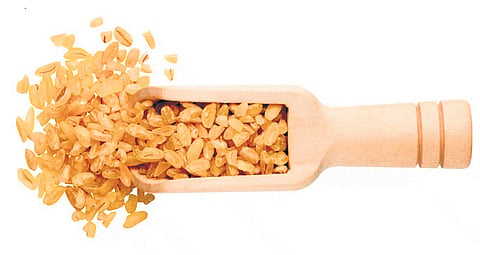Bulgur: A Mesopotamian mystery
Legends have forgotten legacies. Like for example the jewel of Middle Eastern cooking, bulgur.
Loved by Chinese emperors and ancient Babylonians, this popular grain is made from durum wheat and is storming food correctness in fancy kichens with fancier chefs. Ironically, it is considered one of the world’s first processed foods: In eastern Mediterranean villages, the practice still is to boil the wheat in huge pots, even for days, until it is thoroughly cooked. Then dry it on rooftops in the sun, and break up the hardened kernels into coarse pieces. The versatile grain is parted into various sizes for different preparations. Though boiling may remove some vitamins and minerals from the outer layers, they return go the grain when it is cooked.
“Bulgur is a versatile ingredient. At my restaurant Allegro, I have used to it make Bircher muesli, or as a granola crumb mixed with nuts to top off our chia seed pudding. With a lot of our menus focusing on health and wellbeing, I have made a lemon bulgur (my version of a lemon rice) with it and even an Asian version of fried rice with sweet soy sauce, edamame and steamed chicken,” says Apoorva Kunte, executive chef at The Westin Melbourne.
In the history of society, the discovery of wheat led to the growth of agricultural communities and acquired popular approval and imperial acclaim. Sumerian Goddesses of lore have “wheat” in their names. In the 2800’s BC, wheat went divine when Chinese Emperor Shen Nung declared it a holy grain. Then a nameless Bronze Age woman discovered a way to make a new grain from wheat, later called bulgur. It occupied a pedestal in Mesopotamian cuisine thanks to its nutritious benefits; it was also cheaper for labourers to make. “Bulgur has a number of great nutrients, similar to quinoa or couscous. I like its mild flavour and light texture. It is equally suited to both spring and summer when I make fritters with wild garlic, new potatoes and, at times, feta. It goes perfectly with vine-roasted tomatoes,” London-based Michelin Star Chef Atul Kochhar lets you into a bulgur secret.
Available in four grades, ranging from fine to very coarse, its versatility makes it a special grain. World War II combat chefs used it as a staple to feed the troops and also used it as a sand-blasting agent to clean airplane parts. The gourmet battlefield is full of chefs competing to find new ingredients and innovative recipes. “Medium, coarse, or very coarse bulgur is good for pilaf, while the fine version is ideal for tabbouleh and kibbeh,” reveals Arun Thakur, executive sous chef, Shangri-La Eros New Delhi.
Unlike cracked wheat, bulgur is precooked, requiring just 20 minutes of soaking or simmering before preparation. With a delightful nutty flavour and light texture, it works well for quick, tasty meals. “I use it in Gehu Ka Khichda, a traditional dish from Rajasthan, also known as ‘kheech’. It is prepared during Makar Sankranti and Akshaya Tritiya. This luscious sweet delicacy is traditionally crafted from whole wheat, milk, sugar and dry fruits. Distinct from the simple cracked wheat porridge known as dalia, the whole wheat is soaked and husked. We also use bulgur to make laapsi, another delightful dessert, usually made with wheat,” says Chef Abhilasha Jain, founder, Marwadi Khana.
Sustainability and organic being the current buzzwords, chefs like Harish Rao, Master Chef Tamil Season 1, cook the grain in rich vegetable stock to elevate the flavour. “The instant organic stock streamlines the process. Enhanced with robust vegetable stock, onions and a touch of garlic or aired with mixed vegetables, feta and a drizzle of olive oil, bulgur transcends simplicity, guaranteeing enraptured diners.”
In Syria, some weeks after freekeh (roasted green durum wheat) season gets over, the wheat fields shine in the sun like pure gold. It is bulgur season. It is announced across an entire village and it is time to celebrate an ancient tradition dating back to Mesopotamia. The empire is long dead, but the grain thrives as its legacy forever, whether it be in posh restaurants or ancient village kitchens.
BULGUR TEA CAKES
Ingredients:
● Bulgur: 1/4 cup
● Refined flour: 3/4 cup
● Baking powder: 1/2 tsp
● Salt: 1/8 tsp
● Oil: 113 gm
● Vanilla essence: 1 tsp
● Orange zest: 2 tsp
● Eggs: 2
● Caster sugar: 100 gm
● Ube paste: 1 tsp
● Rose water: 1 tsp
● Pandan paste: 1 tsp
For Garnish:
● Soaked bulgur: 2 tsp
● Melted white chocolate: 30 gm
● Baking time: 15 mins
● Baking temp: 180 degrees C
Method:
● In a mixing bowl, break the eggs and add sugar, then whisk at high speed. Add vanilla essence and orange zest, set aside. In another bowl, sieve in refined flour, baking powder, salt and bulgur, then mix. Slowly fold this mixture into the beaten egg-sugar mixture. Add 30-40 ml of refined oil and fold further, then fold in the remaining oil.
● Divide the batter into three parts and fold in the flavourings individually. Allow the batter to rest in the fridge for 30-40 minutes. Brush some oil into the tea cake moulds, remove the batter from the fridge, and spoon it into the moulds filling them 3/4 of the way. Preheat the oven, then bake the tea cakes for 12-14 mins. Remove and allow to cool on a wire rack. Drizzle melted white chocolate over the tea cakes and sprinkle bulgur on top.

